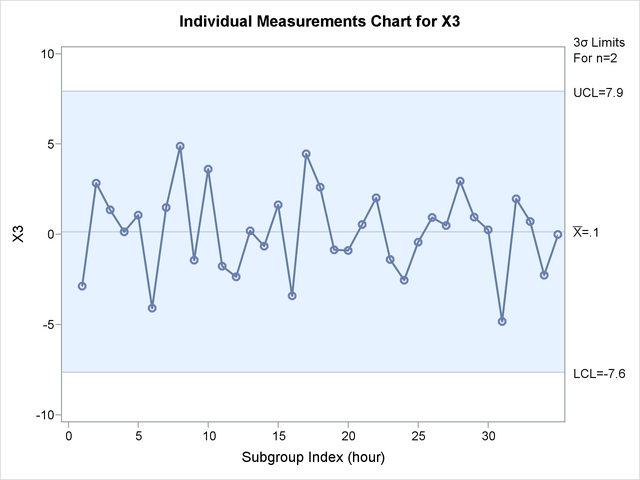The MVPMONITOR Procedure
Example 13.3 Comparison of Univariate and Multivariate Control Charts
This example shows the effect of a change in correlation of the process variables on the SPE chart. The following statements
create a data set called mvpStable, which consists of 30 samples from a trivariate normal distribution with strong positive correlation between all three variables:
proc iml;
Mean = {0,0,0};
Cor = {1.0 0.8 0.8,
0.8 1.0 0.8,
0.8 0.8 1.0};
StdDevs = {2 2 2};
D = diag(StdDevs);
Cov = D*Cor*D; /* covariance matrix */
NumSamples = 30;
call randseed(123321); /* set seed for the RandNormal module */
X = RandNormal(NumSamples, Mean, Cov);
varnames = { x1 x2 x3};
create mvpStable from X [colname = varnames];
append from X;
quit;
run;
data mvpStable;
set mvpStable;
hour=_n_;
run;
The next statements create a data set called mvpOOC, which has five observations in which the correlations are negative:
proc iml;
Mean = {0,0,0};
Cor = { 1.0 -0.8 0.8,
-0.8 1.0 -0.8,
0.8 -0.8 1.0};
StdDevs = {2 2 2};
D = diag(StdDevs);
Cov = D*Cor*D; /* covariance matrix */
NumSamples = 5;
call randseed(123321); /* set seed for the RandNormal module */
X = RandNormal(NumSamples, Mean, Cov);
varnames = { x1 x2 x3};
create mvpOOC from X [colname = varnames];
append from X;
quit;
run;
data mvpOOC;
set mvpStable mvpOOC;
hour=_n_;
run;
The following statements produce a principal component model for the data in mvpStable:
proc mvpmodel data=mvpStable ncomp=1 plots=none out=scores
outloadings=loadings;
var x1 x2 x3;
run;
The model hyperplane that is defined by specifying NCOMP= 1 is a line. The loadings in the principal component model, which are used to project the data to the model hyperplane, are defined by the correlation structure present in the DATA= data set.
The model explains about 90% of the variance in the data, as shown in Output 13.3.1.
Output 13.3.1: Eigenvalue and Variance Information
| Eigenvalues of the Correlation Matrix | ||||
|---|---|---|---|---|
| Eigenvalue | Difference | Proportion | Cumulative | |
| 1 | 2.67725690 | 0.8924 | 0.8924 | |
The loadings from the model are then applied to the data in mvpOOC, which includes observations that have a different correlation structure, which vary in direction orthogonal to the model
line. The following statements apply the loadings to these new data to produce ![]() and SPE charts:
and SPE charts:
proc mvpmonitor data=mvpOOC loadings=loadings; time hour; tsquarechart; spechart; run;
The MVPMONITOR procedure generates a ![]() chart, shown in Output 13.3.2.
chart, shown in Output 13.3.2.
Output 13.3.2: ![]() Chart
Chart
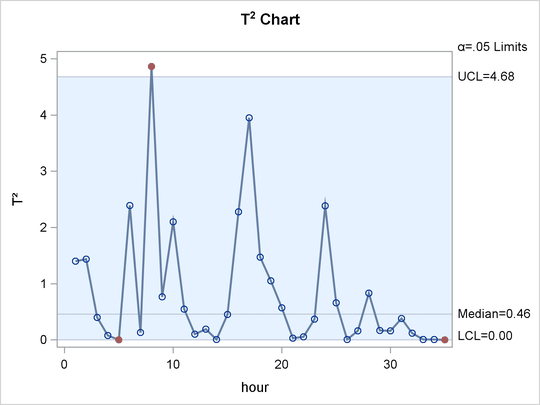
The projection of the last five points to the model line results in small amounts of variation, and thus small ![]() statistics, for two reasons: the last five points are orthogonal to the model line, and they share the same mean. However,
the orthogonality means that they are out-of-control points in the SPE chart.
statistics, for two reasons: the last five points are orthogonal to the model line, and they share the same mean. However,
the orthogonality means that they are out-of-control points in the SPE chart.
The MVPMONITOR procedure also produces an SPE chart, shown in Output 13.3.3.
Output 13.3.3: SPE Chart
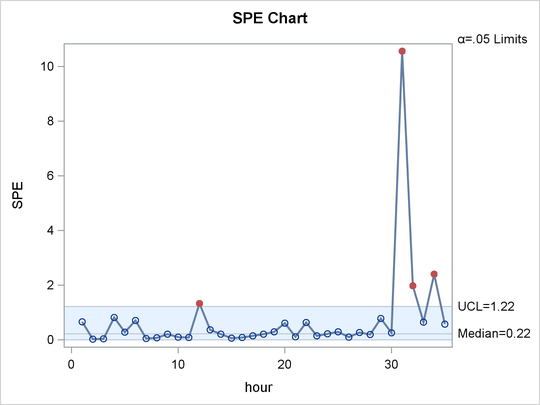
Because the last five points come from a correlation structure that is not seen in the data from which the model was built,
these points can lie far from the model line, resulting in large values in the SPE statistics.
Because the marginal distributions are the same in both the original 30 points and the additional five points, the univariate control charts in Output 13.3.4, Output 13.3.5, and Output 13.3.6 fail to signal the multivariate change at hour 31. The following statements produce univariate control charts for each of the variables by using the SHEWHART procedure:
proc shewhart data=mvpOOC; irchart (x1 x2 x3) * hour / markers nochart2; run;
Output 13.3.4: Univariate Chart for ![]()
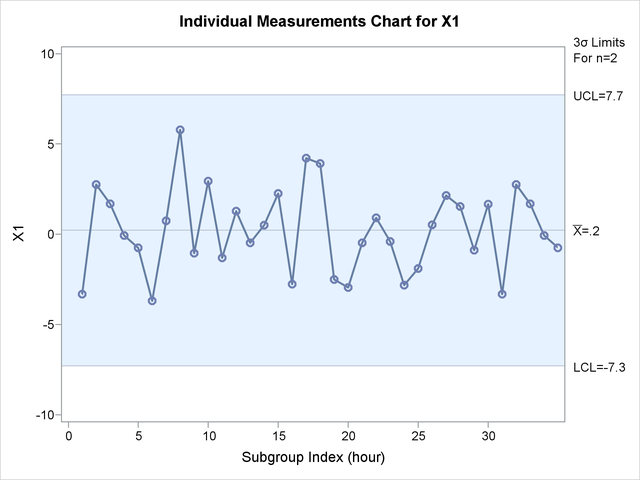
Output 13.3.5: Univariate Chart for ![]()
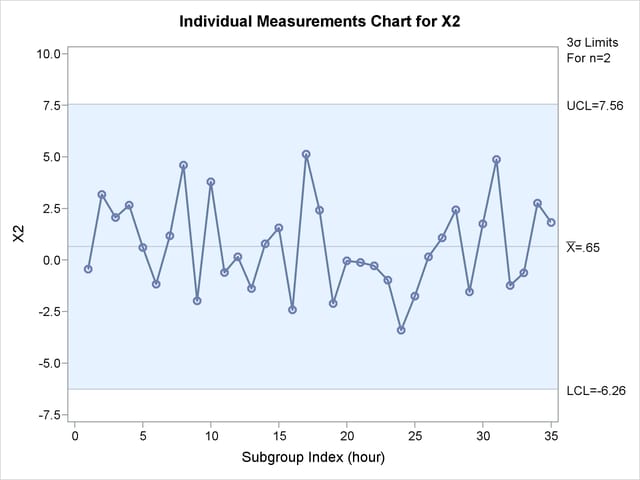
Output 13.3.6: Univariate Chart for ![]()
